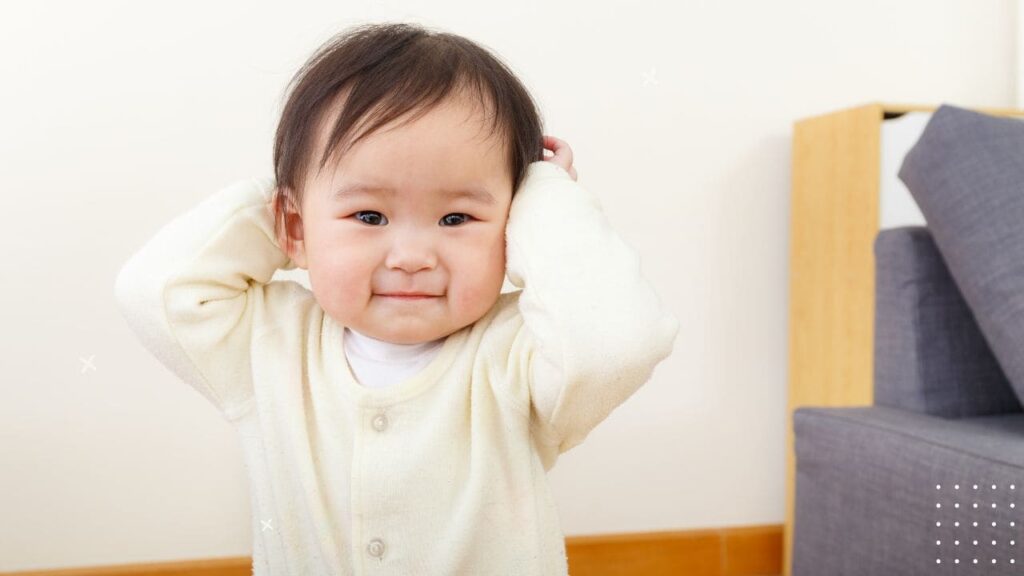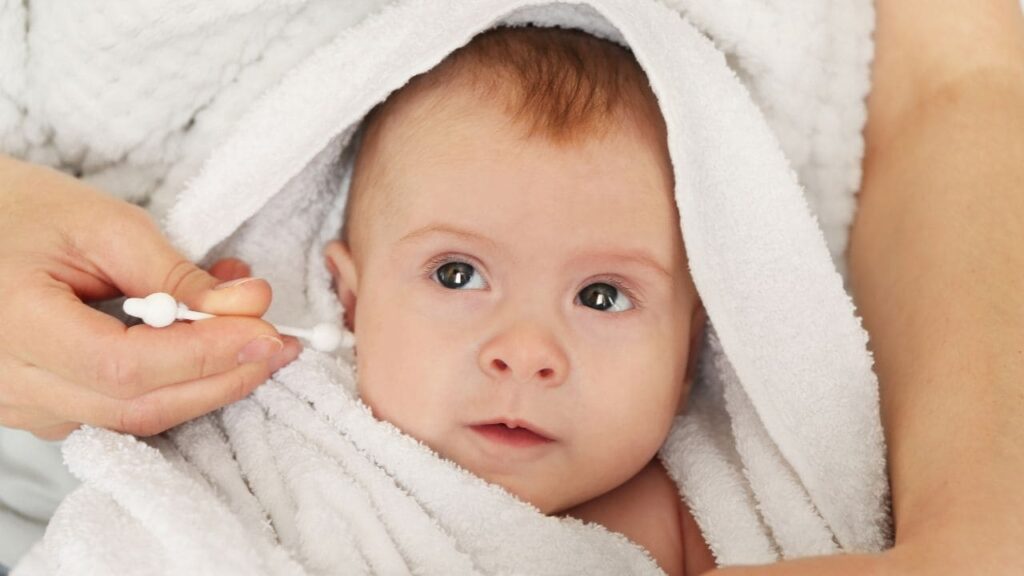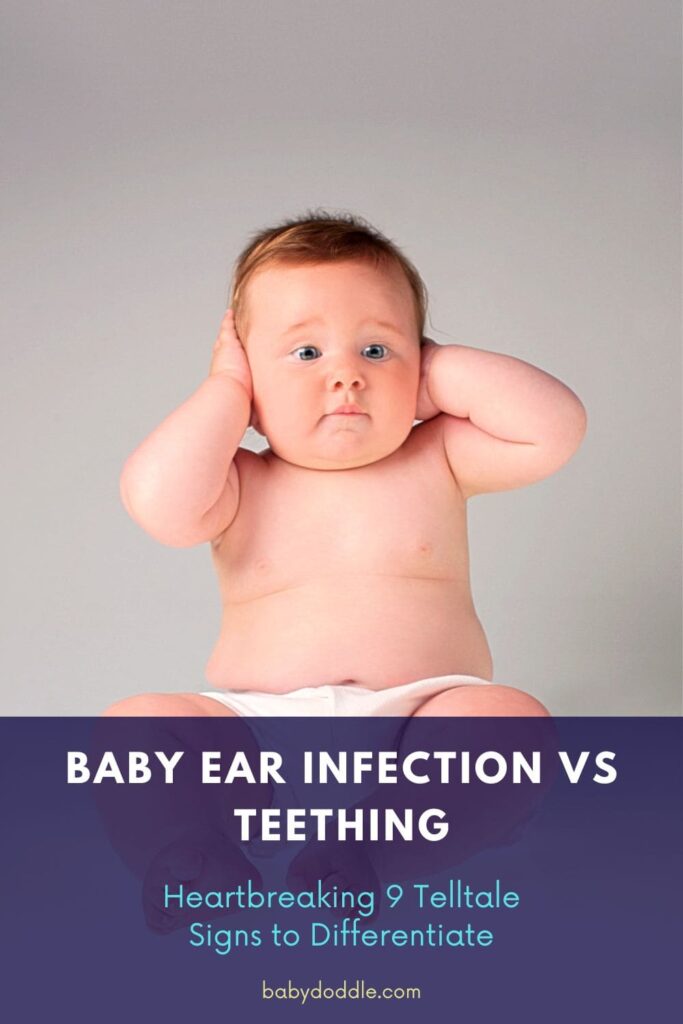Ah, the joys of parenthood! One minute, you’re basking in the sweet giggles and cuddles, and the next, you’re caught in a whirlwind of confusion, trying to decipher the cause of your little one’s distress. Is it an ear infection or just good ol’ teething woes? Trust me, we’ve all been there, frantically searching for answers amid the heartbreaking cries.
As a parent, it’s natural to feel overwhelmed when your baby’s discomfort seems inexplicable. The similarities between ear infections and teething can be downright perplexing, leaving you questioning every fuss and whimper. But fear not, my friends! This blog post is here to shed some much-needed light on the telltale signs that can help you distinguish between these two common culprits.
Understanding Ear Infections in Babies
Before we dive into the nitty-gritty of differentiating, let’s first understand what an ear infection entails. An ear infection, or otitis media, is a painful condition where the middle ear becomes inflamed, often due to bacteria or viruses. It’s a common ailment in little ones, thanks to their narrower Eustachian tubes, which can easily become blocked and create a breeding ground for infection.
Ear infections can be acute (short-lived) or chronic (recurring), and they can range from mild to severe. While some cases may resolve on their own, others may require medical intervention, such as antibiotics or, in more severe cases, ear tube surgery.

Signs of an Ear Infection
- Fever: A higher-than-normal body temperature is often one of the first signs of an ear infection. If your baby’s fever persists or rises above 101°F (38.3°C), it’s best to seek medical attention.
- Ear Tugging or Pulling: Babies may tug or pull at their ears to alleviate the pain and pressure caused by the infection.
- Fussiness or Irritability: Ear infections can make even the happiest of babies utterly miserable. Increased fussiness, crying, and irritability are common signs.
- Difficulty Sleeping: The pain and discomfort can make it challenging for your little one to fall asleep or stay asleep, resulting in crankiness and exhaustion for both baby and parents.
- Loss of Appetite: The pain associated with an ear infection can make feeding times a battle, as your baby may refuse to eat or drink due to the discomfort.
- Ear Drainage: In some cases, you may notice a yellowish or whitish discharge from your baby’s ear, indicating a ruptured eardrum or a more severe infection.
The Teething Process and Its Impact
Ah, teething – the bane of parents everywhere! While it’s a natural and necessary process for your baby’s dental development, it can also be a source of significant discomfort and frustration for both you and your little one.
Teething typically begins around 6 months of age, but the timeline can vary widely from baby to baby. The first teeth to make their grand appearance are usually the two bottom front teeth (central incisors), followed by the four upper front teeth. This process can continue until around the age of 3, with the arrival of the second molars.
As new teeth start to emerge, your baby’s gums may become swollen, tender, and irritated, leading to a whole host of unpleasant symptoms.
Signs of Teething
- Drooling: Excessive drooling is one of the most common signs of teething, as your baby’s increased saliva production helps soothe the aching gums.
- Gum Swelling and Tenderness: The gums around the emerging tooth may appear red, swollen, and tender to the touch.
- Biting or Chewing on Objects: Your little one may try to alleviate the discomfort by gnawing on anything within reach, from their fingers to toys and even furniture.
- Ear Rubbing or Cheek Pulling: The pain and pressure from teething can sometimes radiate to the cheeks and ears, causing your baby to rub or pull at these areas.
- Irritability or Fussiness: As with ear infections, teething can make your baby cranky, fussy, and downright miserable at times.
- Decreased Appetite: The discomfort in their mouth may make eating and drinking less appealing, leading to a temporary decrease in appetite.
Heartbreaking 9 Telltale Signs to Differentiate Between Ear Infections and Teething
Now that we’ve covered the basics of ear infections and teething, it’s time to dive into the telltale signs that can help you distinguish between the two. Here are the heartbreaking 9 signs to watch out for:
- Fever: While a slight elevation in temperature (under 101°F or 38.3°C) can occur during teething, a high and persistent fever is more indicative of an ear infection or another illness.
- Ear Drainage: If you notice any fluid or discharge coming from your baby’s ear, it’s likely an ear infection and not just teething discomfort.
- Difficulty Sleeping: Both conditions can disrupt sleep, but ear infections tend to cause more significant sleep disturbances due to the intense pain involved.
- Loss of Appetite: While teething can temporarily reduce appetite, a complete refusal to eat or drink is more commonly associated with ear infections.
- Excessive Crying or Irritability: While fussiness is common during teething, inconsolable crying or extreme irritability may signal an ear infection or another underlying issue.
- Ear Tugging or Pulling: If your baby is persistently tugging or pulling at their ear, it could be a sign of an ear infection rather than just teething discomfort.
- Drooling or Gum Swelling: Excessive drooling and swollen, tender gums are classic signs of teething, whereas an ear infection is less likely to cause these specific symptoms.
- Ear Rubbing or Cheek Pulling: While teething can cause referred pain in the cheeks and ears, excessive rubbing or pulling at these areas may indicate an ear infection.
- Duration and Intensity of Symptoms: Teething discomfort typically comes and goes in waves, whereas ear infection symptoms tend to be more constant and severe.
| Symptom | Ear Infection | Teething |
|---|---|---|
| Fever | High and persistent fever (above 101°F/38.3°C) | A temporary decrease in appetite |
| Ear Drainage | Yes | No |
| Difficulty Sleeping | Significant sleep disturbances | Moderate sleep disturbances |
| Loss of Appetite | Complete refusal to eat or drink | Temporary decrease in appetite |
| Excessive Crying/Irritability | Inconsolable crying | Fussiness and irritability |
| Ear Tugging/Pulling | Yes | No |
| Drooling | No | Yes |
| Gum Swelling | No | Yes |
| Ear/Cheek Rubbing | Yes | Sometimes |
| Duration and Intensity | Duration and Intensity | Comes and goes in waves |
It’s important to note that some babies may experience a combination of these signs, making it even more challenging to pinpoint the root cause. In such cases, it’s always best to consult your pediatrician for a proper diagnosis and treatment plan.
While we’ve outlined the key differences between ear infections and teething, it’s essential to acknowledge that some symptoms can overlap. Both conditions can cause fussiness, irritability, and difficulty sleeping, which can make it challenging for parents to identify the underlying issue.
This is where keen observation and a deep understanding of your baby’s behavior become crucial. Pay close attention to the duration, intensity, and combination of symptoms your little one is experiencing. For example, if your baby is consistently tugging at their ear, has a high fever, and is refusing to eat or drink, it may be more indicative of an ear infection than teething alone.

The Importance of Proper Diagnosis
While it’s essential to understand the differences between ear infections and teething, it’s equally crucial to seek proper medical diagnosis, especially when symptoms persist or worsen. Self-diagnosis can be challenging, and misidentifying the underlying issue can lead to improper treatment, prolonged discomfort for your baby, and potential complications.
Pediatricians are trained to conduct thorough examinations, including using specialized tools like otoscopes to visually inspect the ear canal and eardrum. They may also order additional tests, such as tympanometry (a test that measures the mobility of the eardrum) or imaging studies, if necessary.
Receiving an accurate diagnosis is vital for determining the appropriate course of action. In the case of an ear infection, your pediatrician may prescribe antibiotics or recommend other treatments to alleviate pain and prevent further complications. On the other hand, if it’s determined that your baby is teething, your pediatrician can provide guidance on safe and effective home remedies to manage the discomfort.
It’s important to remember that while teething is a natural process, it should not cause excessive or prolonged distress. If your baby’s teething symptoms seem unusually severe or persistent, it’s best to consult your pediatrician to rule out any underlying issues.
When to Seek Medical Attention
As a parent, trusting your instincts is paramount. If you suspect that your baby’s discomfort goes beyond the typical teething woes, it’s always better to err on the side of caution and seek medical attention.
If You Think It’s an Ear Infection
Here are some specific signs that should prompt you to schedule an appointment with your pediatrician:
- High and persistent fever (over 101°F or 38.3°C)
- Ear drainage or discharge
- Severe or inconsolable crying
- Persistent ear tugging or pulling
- Difficulty sleeping or staying asleep
- Loss of appetite or refusal to eat or drink
Your pediatrician can perform a thorough examination, including checking your baby’s ears with an otoscope, to determine if an ear infection is present. They may also recommend additional tests or treatment options, such as antibiotics or pain relievers, depending on the severity of the infection.
Remember, early intervention is key to preventing complications and ensuring your baby’s comfort and well-being.
Home Remedies and Tips for Relieving Discomfort
While medical attention is necessary for ear infections, there are also some safe and effective home remedies that can help alleviate discomfort for both ear infections and teething. However, it’s crucial to consult your pediatrician before trying any remedies, especially if your baby is under six months old or has any underlying medical conditions.
Home Remedies for Ear Infections
- Over-the-Counter Pain Relievers: With your pediatrician’s approval, you can give your baby age-appropriate doses of acetaminophen or ibuprofen to help reduce pain, fever, and inflammation associated with ear infections.
- Warm Compresses: Applying a warm, damp cloth or heating pad (on a low setting) to the affected ear can provide temporary relief by increasing blood flow and relaxing the area.
- Keeping the Baby Upright: Holding or positioning your baby in an upright position can help drain fluid from the middle ear and alleviate pressure.
- Humidifiers: Using a cool-mist humidifier in your baby’s room can add moisture to the air, which can help thin out mucus and reduce inflammation in the Eustachian tubes.
If Your Baby Is Teething
- Cold Teething Rings or Toys: Chilled (but not frozen) teething rings or toys can provide soothing relief for your baby’s sore gums. The cold temperature helps numb the pain and reduce inflammation.
- Gum Massages: Gently massaging your baby’s gums with a clean finger or a cool, damp cloth can help alleviate pressure and discomfort.
- Over-the-Counter Pain Relievers: As with ear infections, your pediatrician may recommend age-appropriate doses of acetaminophen or ibuprofen to help manage teething pain.
- Teething Biscuits or Frozen Fruits/Vegetables: Chilled or frozen (but not rock-solid) teething biscuits, fruits, or vegetables can provide a soothing sensation on your baby’s gums while also offering a safe, edible option for gnawing.
It’s important to note that while these remedies can provide temporary relief, they do not address the underlying cause of the discomfort. If your baby’s symptoms persist or worsen, it’s always best to consult your pediatrician for proper treatment.
Prevention and Care for Ear Infections and Teething
While ear infections and teething are common occurrences in a baby’s life, there are steps you can take to help reduce the risk and manage the discomfort more effectively.
- Good Hygiene: Practicing good hygiene, such as washing hands frequently and keeping your baby’s toys and surroundings clean, can help prevent the spread of germs that can lead to ear infections.
- Breastfeeding: Breastfeeding can provide your baby with antibodies that help strengthen their immune system and reduce the risk of ear infections.
- Regular Checkups: Attending regular well-baby visits and keeping up with recommended vaccinations can help identify and prevent potential health issues, including ear infections.
- Avoiding Secondhand Smoke: Exposure to secondhand smoke can increase the risk of ear infections and other respiratory problems in babies.
- Teething Accessories: Providing safe, chilled teething rings or toys can help alleviate teething discomfort and prevent your baby from gnawing on potentially harmful objects.
- Patience and Comfort: Teething and ear infections can be challenging for both babies and parents, so it’s essential to have patience and offer plenty of comfort, cuddles, and reassurance during these trying times.

The Role of Breastfeeding in Prevention
Breastfeeding has long been recognized for its numerous benefits, and one of those advantages is its potential to reduce the risk of ear infections in babies. The antibodies present in breast milk help strengthen a baby’s immune system, making it more resilient against infections, including those affecting the ear.
According to a study published in the journal Pediatrics, babies who were exclusively breastfed for the first six months had a significantly lower risk of developing ear infections compared to those who were formula-fed or received mixed feeding. The study also found that the protective effect of breastfeeding persisted even after the introduction of solid foods.
Breastfeeding not only provides antibodies but also fosters a closer physical connection between mother and baby, which can be soothing during times of discomfort, such as teething. The act of breastfeeding itself can help calm and comfort a fussy, teething baby, thanks to the release of hormones like oxytocin, which promote relaxation and bonding.
While breastfeeding is not a guarantee against ear infections or a cure for teething woes, it can be a valuable tool in your parenting arsenal, providing both nutritional and emotional benefits for your little one.
Conclusion
Navigating the world of baby discomfort can be a daunting task, but with the right knowledge and a keen eye for telltale signs, you can confidently decipher whether your little one is battling an ear infection or the dreaded teething woes.
Remember, trust your instincts, and don’t hesitate to seek medical advice when in doubt. Early intervention can not only provide relief for your baby but also prevent potential complications and ensure their overall well-being.
Throughout this journey, remember to take a deep breath, offer plenty of cuddles and comfort, and know that this too shall pass. Your unwavering love and care are the most potent remedies of all.
So, fellow parents, embrace the challenges, celebrate the milestones, and cherish every moment with your little bundle of joy. Together, we’ve got this!
Coping Strategies for Parents
Navigating the challenges of ear infections and teething can be physically and emotionally draining for parents. While your primary focus is on your baby’s well-being, it’s equally important to prioritize your own self-care during these trying times.
Here are some coping strategies that can help you maintain your sanity and resilience:
- Build a Support System: Reach out to friends, family members, or join parent support groups (online or in-person) where you can share your experiences, seek advice, and find emotional support. Knowing that you’re not alone in this journey can be incredibly reassuring.
- Practice Self-Care: Make time for activities that help you recharge and relieve stress, whether it’s taking a warm bath, practicing yoga or meditation, or engaging in a hobby you enjoy. Even small pockets of “me-time” can make a significant difference in your overall well-being.
- Take Breaks: If you have a partner or someone who can provide temporary relief, don’t hesitate to take turns caring for your baby. A break, even if it’s just a few hours, can help you reset and return with renewed energy and patience.
- Seek Professional Help: If you’re experiencing symptoms of depression, anxiety, or overwhelm, don’t hesitate to reach out to a mental health professional. Postpartum mood disorders are common, and seeking support is a sign of strength, not weakness.
- Celebrate Small Victories: Parenting can be a rollercoaster of emotions, so it’s essential to acknowledge and celebrate the small victories along the way. Whether it’s a peaceful nap, a successful feeding session, or a moment of laughter amid the chaos, savor those moments and use them as reminders of the joy that comes with parenthood.
Remember, you are not alone in this journey. By taking care of yourself, you’ll be better equipped to provide the love, care, and support your baby needs during these challenging times.
FAQ – Baby ear infection vs teething
Can teething cause a high fever?
While it’s common for babies to experience a slight rise in temperature during teething, a high and persistent fever (over 101°F or 38.3°C) is typically not associated with teething alone. A high fever can be a sign of an underlying infection, such as an ear infection, or another illness.
If your baby is teething and has a high fever, it’s essential to monitor them closely and seek medical attention if the fever persists or is accompanied by other concerning symptoms like excessive fussiness, loss of appetite, or ear tugging. Your pediatrician can perform a proper examination and determine if the fever is related to teething or if there is an underlying condition that requires treatment.
How can I tell if my baby’s ear pain is from teething or an ear infection?
Distinguishing between teething pain and ear pain can be challenging, as both conditions can cause discomfort in the ear or cheek area. However, there are a few key indicators to help you differentiate:
- Ear tugging: If your baby is persistently tugging or pulling at their ear, it may be a sign of an ear infection rather than just teething discomfort.
- Ear drainage: If you notice any fluid or discharge coming from your baby’s ear, it’s likely an ear infection and not related to teething.
- Fever: While teething can cause a slight fever, a high and persistent fever (over 101°F or 38.3°C) is more indicative of an ear infection or another illness.
- Intensity and duration: Teething discomfort typically comes and goes in waves, whereas ear infection pain tends to be more constant and severe.
If you’re unsure or if the symptoms persist, it’s always best to consult your pediatrician for a proper diagnosis and appropriate treatment.
Can teething cause diarrhea or vomiting?
No, teething is not typically associated with diarrhea or vomiting. While teething can cause drooling, decreased appetite, and fussiness, it should not lead to gastrointestinal issues like diarrhea or vomiting.
If your baby is experiencing diarrhea or vomiting alongside other teething symptoms, it’s likely an indication of another underlying illness, such as a viral or bacterial infection, and you should seek medical attention promptly. Dehydration can occur quickly in babies with diarrhea or vomiting, so it’s important to address the issue as soon as possible.
How long do ear infections typically last in babies?
The duration of an ear infection can vary, but most acute ear infections in babies resolve within 3-7 days with proper treatment, such as antibiotics or pain relief medication prescribed by your pediatrician.
However, if your baby’s symptoms persist beyond a week or worsen, it’s crucial to follow up with your pediatrician. Prolonged or recurrent ear infections can lead to complications like hearing loss or ruptured eardrums if left untreated.
It’s important to complete the entire course of antibiotics (if prescribed) and attend follow-up appointments to ensure the infection has cleared completely.
Are there any long-term effects of frequent ear infections in babies?
While occasional ear infections are common in babies and typically resolve with proper treatment, frequent or recurrent ear infections can potentially lead to long-term complications if left unaddressed.
Some potential long-term effects of frequent ear infections in babies include:
- Hearing loss: Persistent fluid buildup or damage to the eardrum can impair hearing, which can affect speech and language development.
- Speech and language delays: If hearing loss occurs during critical periods of language development, it can hinder the acquisition of speech and language skills.
- Behavioral or learning difficulties: Chronic ear infections and associated hearing loss have been linked to challenges with behavior, attention, and academic performance in some children.
- Structural changes in the ear: Repeated infections can cause structural changes in the middle ear, potentially leading to the need for ear tube surgery or other interventions.
If your baby experiences frequent or recurrent ear infections, it’s essential to work closely with your pediatrician to manage the condition and prevent potential long-term complications. Early intervention and proper treatment are crucial for protecting your baby’s hearing, speech, and overall development.
Remember, while ear infections and teething can be challenging, seeking prompt medical attention and following your pediatrician’s guidance can help ensure your baby’s comfort and well-being.












